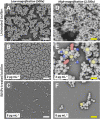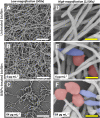Bismuth nanoparticles obtained by a facile synthesis method exhibit antimicrobial activity against Staphylococcus aureus and Candida albicans
- PMID: 33073175
- PMCID: PMC7558697
- DOI: 10.1186/s42490-020-00044-2
Bismuth nanoparticles obtained by a facile synthesis method exhibit antimicrobial activity against Staphylococcus aureus and Candida albicans
Abstract
Background: Bismuth compounds are known for their activity against multiple microorganisms; yet, the antibiotic properties of bismuth nanoparticles (BiNPs) remain poorly explored. The objective of this work is to further the research of BiNPs for nanomedicine-related applications. Stable Polyvinylpyrrolidone (PVP)-coated BiNPs were produced by a chemical reduction process, in less than 30 min.
Results: We produced stable, small, spheroid PVP-coated BiNPs with a crystalline organization. The PVP-BiNPs showed potent antibacterial activity against the pathogenic bacterium Staphylococcus aureus and antifungal activity against the opportunistic pathogenic yeast Candida albicans, both under planktonic and biofilm growing conditions.
Conclusions: Our results indicate that BiNPs represent promising antimicrobial nanomaterials, and this facile synthetic method may allow for further investigation of their activity against a variety of pathogenic microorganisms.
Keywords: Antimicrobial nanomaterials; Bacteria; Biofilms; Bismuth nanoparticles; Fungi; Nanoantibiotics.
© The Author(s) 2020.
Conflict of interest statement
Competing interestsThe authors declare that there is no conflict of interest. The funders had no role in study design, data collection, data analysis, decision to publish, or preparation of the manuscript.
Figures






Similar articles
-
Bismuth Nanoantibiotics Display Anticandidal Activity and Disrupt the Biofilm and Cell Morphology of the Emergent Pathogenic Yeast Candida auris.Antibiotics (Basel). 2020 Jul 29;9(8):461. doi: 10.3390/antibiotics9080461. Antibiotics (Basel). 2020. PMID: 32751405 Free PMC article.
-
Fast, facile synthesis method for BAL-mediated PVP-bismuth nanoparticles.MethodsX. 2020 Apr 19;7:100894. doi: 10.1016/j.mex.2020.100894. eCollection 2020. MethodsX. 2020. PMID: 32405464 Free PMC article.
-
Antimicrobial and anti-biofilm activities of Bi subnitrate and BiNPs produced by Delftia sp. SFG against clinical isolates of Staphylococcus aureus, Pseudomonas aeruginosa, and Proteus mirabilis.IET Nanobiotechnol. 2019 Jun;13(4):377-381. doi: 10.1049/iet-nbt.2018.5102. IET Nanobiotechnol. 2019. PMID: 31171741 Free PMC article.
-
The role of bismuth nanoparticles in the inhibition of bacterial infection.World J Microbiol Biotechnol. 2023 May 9;39(7):190. doi: 10.1007/s11274-023-03629-w. World J Microbiol Biotechnol. 2023. Retraction in: World J Microbiol Biotechnol. 2023 Aug 11;39(10):275. doi: 10.1007/s11274-023-03724-y. PMID: 37156882 Free PMC article. Retracted. Review.
-
A review on the potential use of bismuth nanoparticles in oral health.Microb Pathog. 2025 Jan;198:107131. doi: 10.1016/j.micpath.2024.107131. Epub 2024 Nov 16. Microb Pathog. 2025. PMID: 39557226 Review.
Cited by
-
Nanotechnology-Based Strategies to Combat Multidrug-Resistant Candida auris Infections.Pathogens. 2023 Aug 13;12(8):1033. doi: 10.3390/pathogens12081033. Pathogens. 2023. PMID: 37623993 Free PMC article. Review.
-
Beyond the Nanomaterials Approach: Influence of Culture Conditions on the Stability and Antimicrobial Activity of Silver Nanoparticles.ACS Omega. 2020 Oct 26;5(44):28441-28451. doi: 10.1021/acsomega.0c02007. eCollection 2020 Nov 10. ACS Omega. 2020. PMID: 33195894 Free PMC article.
-
Colloidal dispersion of poly(ionic liquid)/Cu composite particles for protective surface coating against SAR-CoV-2.Nano Sel. 2022 Jan;3(1):227-232. doi: 10.1002/nano.202100069. Epub 2021 Jun 1. Nano Sel. 2022. PMID: 34485979 Free PMC article.
-
Recent Advances in the Development of Lipid-, Metal-, Carbon-, and Polymer-Based Nanomaterials for Antibacterial Applications.Nanomaterials (Basel). 2022 Nov 1;12(21):3855. doi: 10.3390/nano12213855. Nanomaterials (Basel). 2022. PMID: 36364631 Free PMC article. Review.
-
Self-assembled BiFeO3@MIL-101 nanocomposite for antimicrobial applications under natural sunlight.Discov Nano. 2023 Sep 11;18(1):113. doi: 10.1186/s11671-023-03883-9. Discov Nano. 2023. PMID: 37697156 Free PMC article.
References
-
- Sun H. Biological chemistry of arsenic, antimony and bismuth. Biological chemistry of arsenic, antimony and bismuth: Wiley; 2010. p. 383. [cited 2019 May 14]. Available from: https://books.google.com/books?hl=en&lr=&id=nrKXcXQF0QAC&oi=fnd&pg=PR13&....
-
- Badireddy AR, Hernandez-Delgadillo R, Sánchez-Nájera RI, Chellam S, Cabral-Romero C. Synthesis and characterization of lipophilic bismuth dimercaptopropanol nanoparticles and their effects on oral microorganisms growth and biofilm formation. J Nanopart Res. 2014;16(6):2456. doi: 10.1007/s11051-014-2456-5. - DOI
-
- USGS . Bismuth statistics and information [internet]. National Minerals Information Center. 2019.
LinkOut - more resources
Full Text Sources
Other Literature Sources
